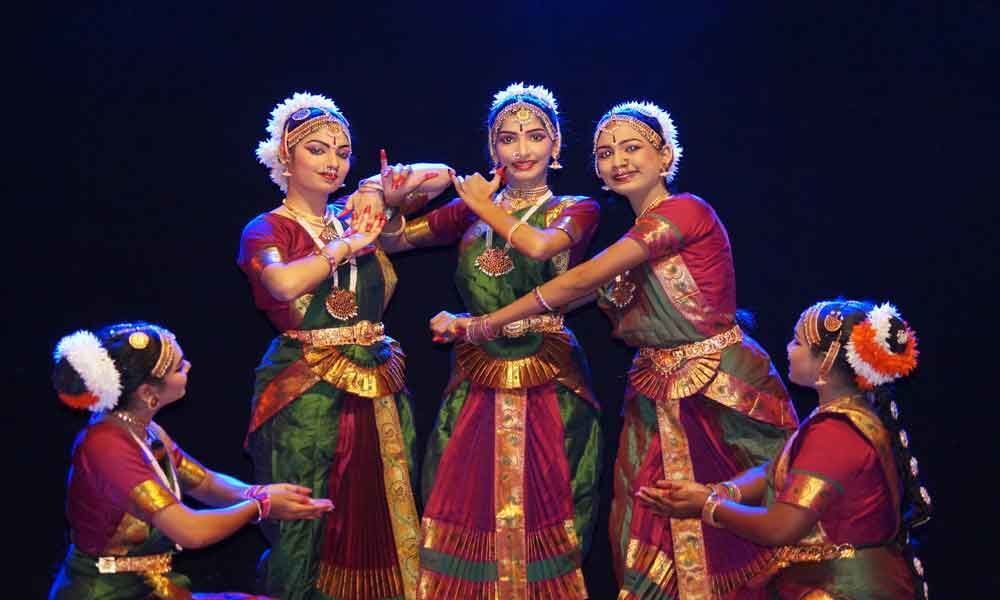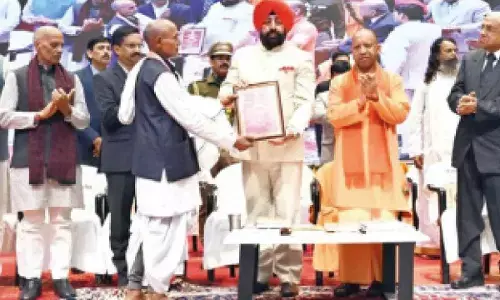A uniquely invocatory performance
 A uniquely invocatory performance
A uniquely invocatory performanceThe fourth anniversary celebrations of Srivari Padalu Bharatanatyam Dance Academy headed by guru N Rama Devi was held at Ravindra Bharati on Wednesday.
The fourth anniversary celebrations of Srivari Padalu Bharatanatyam Dance Academy headed by guru N Rama Devi was held at Ravindra Bharati on Wednesday.
Over 80 students participated win the programme. It started with Pushpanjali, the invocation dance in a Bharatanatyam performance. It is the salutation to the lord Nataraja, the guru, the musicians and the audience. This was in Amruthavashini ragam done by the youngest students aged from five to six years.
A Ganesh slokam in praise of the elephant headed God followed. Mallari is mostly a temple item. Mooshikavahana detailing the vehicle of Lord Ganesha was a pleasure to watch. Varnam "Sri Krishna Kamalanatho" is an astothara shatha namavali.
It was a perfect synchronisation of bhava, raaga and taala, thus giving the young dancers abundant scope for displaying their rhythmic talents along with rich and variegated abhinaya. It is also a measure of one of the 'Dashapraanas' , that is 'ashrama'(endurance), since it is the longest and the most demanding item where in the dancer uses her feet dancing to the Adavu-Jatis, the hands and the hastaas indicating the meaning of the song, while the feeling (inner emotion) is portrayed by the saatvika abhinaya through subtle facial expressions.
Lord Krishna, the all attractive supreme personality of Godhead, known as Lord Vasudeva, is the Lord of Lakshmi-Devi, eternal, the transcendental son of Vasudeva, pure, and His form resembles that of a human being.
Lord Krishna killed Putana and broke the demon Sakatasura apart. Lord Krishna is the youthful butter-thief, and the merciful benedictory of King Mukunda. He is the lord of 16,000 queens, and His three-fold bending form is charming.Lord Krishna is the chariot driver of Arjuna, and He established King Yudhisthira as the king of the entire world. This item was in ragam Reethigowala.
"Kanchadalayadakshi Kamakshi " was in Kamala Manohari composed by Muthuswami Dikshitar. He beautifully brings in the raaga mudra in the Pallavi itself. This raga has become so famous exclusively because of this Krithi that people refer to the raga itself as Kamalamanohari. As we mentioned above, the krithi starts off with the avarohanam- at "Kanchadalayadakshi".
The final oscillating gandaram here gives the krithi a wonderful flavour. He immediately follows this with the avrohanam at "Kamaksi". The gandaram seems to carry a really nice tone that gives this raga its identity and Dikshithar has repeatedly emphasized the usage of this gandaram in this krithi. Annamaya Keertanas 'Kondalalo nelakonna koneti rayadu vadu " and "Adivo alladivo Sri harivasamu" were next."Chakkani talliki changu Bala' had these exquisite lyrics:
"With graceful movements of rejoice that are pouring out; to her beautiful stares extend appreciation with graceful words, chiding her husband to the unsteady displeasure extend appreciation" "Saveri Jathiswaram" was a pure dance presentation, devoid of any abhinaya (emotions), in which, intricate sequences are fused with repetitive musical notes.
The dance deals with the execution of adavus (basic steps) and mudras (hand gestures). An Astalaxmi strotam and a briskly vibrant Kavadi chindhu were followed by a Bharatanatyam fusion Jathi which was full of energy.
Nrittanjali, was a unique invocatory piece in the pure dance genre which involves an arresting array of body movements and foot work. Here, sacred texts by ancient saints in praise of Ardha Nariswara (the half woman manifestation of Shiva), Harihara (the form of Shiva who is half Vishnu) and Amma (the universal mother) have been adapted for music and dance. Each presentation was a fine synthesis of superior music, dance and lyrics and sets a new benchmark for aspiring dancers.
The performance is preceded by a coherent introduction of the item and word-by-word description of the lyrics, context and the mood portrayed in it.Nriitanjali- Saraswathy and bahudari-Adi, followed by Hariharan sthuthi -ragamalika -Adi (verses from Sri Adi Shankara's shivananda lahari).Tillana or thillana is a rhythmic piece in Carnatic music that is generally performed at the end of a concert and widely used in classical Indian dance performances.
A tillana uses tala-like phrases in the pallavi and anupallavi, and lyrics in the charanam. Some have theorized that it is based on the Hindustani tarana. In Purvi this performance by Yuga Rani, Rohitha and Durga was scintillating.

















